
Random Thoughts
by Dave Landry
I think I’m going to be a surgeon tomorrow. I’ll stop by Wally World tonight and pick up some Xacto knives. I guess I better get some rags too. Obviously, even Ludacris would say that’s ludicrous. Yet, that’s how many begin their trading career. They dive in head first and expect immediate positive results.
Self-imposed deadlines are likely your biggest enemy to becoming a successful trader. The good news is that you created this problem and you can easily fix it. Give yourself the gift of time. Here’s how:
1. Give Yourself Time To Sharpen Your Ax

There’s not much in trading that’s like the real world but needing some time to become successful is. You didn’t become the aforementioned surgeon, lawyer, or automatic transmission mechanic overnight. Trading is no different. You’ll need time to learn a viable methodology.
We all end up on a Grail hunt at some point, searching for the secret that will lead to untold riches. The problem is that while looking for the good, we tend to ignore the bad and even worse, the ugly.

Once you do find something, you have to then "pick it apart." You have to play devil’s advocate. Ask yourself, what can go wrong? Is it just an aberration? There were a lot of “system writers” born shortly after 1999. They showed how their “historically tested” (i.e. perfect hindsight) systems printed money. Of course they did. The market went straight up. It’s what happened next in real-time that’s relevant.
2. Give Yourself Time For Experience

You’ll need time to experience a variety of market conditions and time to make mistakes. The map is not the territory. As I wrote in “Layman’s:” I’ve never met an unsuccessful paper trader. Further, as I often preach, “Everyone has a plan until they get punched in the face.” (Mike Tyson) You won’t know how you’ll react to the heat of battle until you are actually there.
People often show me highly accurate systems that take small gains and huge losses—just the opposite of what you should be doing. They do look good on paper-and who doesn’t want a “monthly income machine?” Unfortunately, Beatrice, that’s not how this works. That’s not how ANY of this works. Could you really survive a huge drawdown and then start from scratch? When presented with these so called “anthill” strategies and my argument against falls on deaf ears, I say, okay fine: trade the system for the next 3 years and get back to me. In the last 20-something years, not one person has gotten back to me.

Again, you’ll have to experience a variety of conditions. Maybe the next bear market won’t be just around the corner. So, if it isn’t, just make sure that you study previous ones so that you truly do embrace the fact that markets go up and markets go down. They also sometimes go sideways, so study that too.
On the surface, trading looks a lot easier than it really is. It’s not difficult and certainly not as difficult as many try to make it. That’s the good news. Unfortunately, the bad news is that “not difficult” is not the same as easy.

Curtis Faith
"The great irony of trading is that it is difficult precisely because it is so very simple."
3. Give Yourself Time To Wait For Opportunities
The easiest way to avoid losing money is to not put any at risk. Yet, the only way to make money is to put capital into harm’s way. That’s the trader’s paradox. The irony is that the longer I’m in this career, the less I trade. It’s become a game. How do I make money while not losing any? Well, you can’t but you certainly can pick your spots really carefully. And, if done properly, the money you make will far offset the money you lose-not all day, not every day, and sometimes, not even every year. It’s not important to be right every time as long as you are right over time. Write that down.

When you feel that it is time to trade, you need to ask yourself: Do you really think that you have the mother-of-all setups? Have you exhausted all possibilities? Seriously? Have you sifted through a couple thousand stocks to get here? I often get emails asking me about one particular stock, over and over, day after day. You do know that there are a few thousand other ones out there? Before I digress too far…(too late?)…Have you looked at all major and not so major sectors to see where the opportunities are? And, have you looked at EVERY other tradable stock in the sector of your setup? Does the market, sector, and stocks within the sector agree with your analysis? If all of the pieces aren’t there, do you still really think you have the mother-of-all setups? (i.e. a setup that can stand on its own merits) Then, by all means, TAKE IT. Just don’t forget to ask yourself, could you walk away and be okay? No choice is a choice. Like Rush (referring to the band on their 401k tour) once said: “If you choose not to decide, you still have made a choice." Seriously, no choice is ALWAYS an option. And, even though I’m here at davelandry.com to teach trading, sometimes not trading is the best course of action. That’s another one of the ironies of this business. You’re not going to make money in any other career by sitting on your buttocks. And, you’re not going to make money in trading either by doing nothing but sometimes that’s the thing to do. Return of capital is sometimes more important than return on capital.
So, give yourself time to wait for the so called fat pitch. As I wrote in a previous column:

“I’m not a big sports fan but I can occasionally be found in the nosebleed section of the Superdome watching the Saints. Anyway, based on some Googling, in baseball the ‘fat pitch’ is a hittable ball. It is so called because to the pro player, the ball looks huge. There’s no guarantee that you’ll hit the ball, but you have to swing because the odds are more in your favor. Swinging at anything less than the fat pitch—non hittable balls-all but ensures that you will strikeout.”
So, again, wait for the fat pitch and only swing at those.

As I wrote in the Layman’s Guide To Trading Stocks, Tom Petty got it right, “the waiting is the hardest part.” We crave excitement as humans. In this so called microwave society, we have grown accustomed to instant gratification. It’s hard to wait. Although society pressures for instant gratification are more now than they have ever been, human nature was human nature even 100 years ago. As Livermore wrote:
“…I let the craving for excitement get the better of my judgment…….The desire for constant action irrespective of underlying conditions is responsible for many losses in Wall Street even among professionals, who feel that they must take home some money every day, as though they were working for regular wages.”
It’s really hard to stop quoting Livermore once you start. A corollary to the above is:

“Remember this: When you are doing nothing, those speculators who feel they must trade day in and day out, are laying the foundation for your next venture. You will reap the benefits from their mistakes.
The point is that the market really doesn’t care about your self imposed time-frame.
In Summary
You didn't become the great success you are in your current career overnight. It took some time. Treat trading like any other profession.
Only you can give yourself the gift of time. Give yourself time to learn, time for experience, and time to wait for opportunities.
May the trend be with you!

Dave Landry
If you liked this column, please "Like" it, Tweet it, share it on Facebook (see left side of this column for Twitter & Facebook), and swipe left. If you didn't like it, go have no fun somewhere else (I'm half kidding!).
Three Steps To Fixing The Trading Problem That You Created

